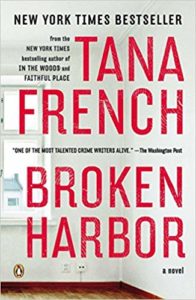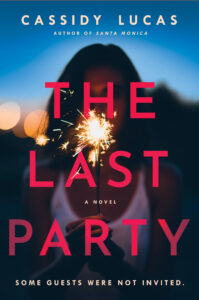Deconstructing the craft of literary fiction in order to create our own is the standard approach to “learning” to write and the foundation of the MFA workshop. Aspiring or current writers of commercial or mass-market fiction, on the other hand, have a less clear-cut course of study. While the distinction between literary and commercial fiction could certainly warrant its own essay, and has certainly been the subject of standalone debate, I’ll propose, for purposes of this piece, that aside from the obvious role of corporate marketing decisions, commercial novels are defined by reader experience. For me, it’s the sense, when I reach the end of a novel, that its parts were bigger than its sum. This is not a lesser experience than finishing a literary novel; but merely different in that my peak enjoyment derives from an irrepressible desire to find out what happens next, i.e., from my investment in plot. The apex of my pleasure generally occurs while I’m actually reading the book, and fades steadily after I’ve finished the last sentence. By contrast, the pleasures of “literary” fiction are often a slower, longer-lasting burn and borne from a medley of craft component in addition to plot: character, atmosphere, lyricism, psychological nuance, etc. While great literary novels can certainly be plot-heavy page-turners, I’d venture that generally, their authors attention to other elements of craft is more evenly dispersed than that of the commercial novelist whose efforts skew heavily toward storyline.
Where then, can aspiring writers of commercial fiction—specifically, commercial thrillers, like the ones I’ve focused on writing in recent years—turn to develop and hone their craft? Yes, learning the mechanics of a killer plot is certainly helpful, but plot alone cannot create that sublime escapist experience of needing to keep reading, no matter how late the hour or the pressing your other obligations. While any first-year MFA student can usually explain how certain classic short stories or novels “work” to create a profound reading experience, I rarely encounter craft-based analysis of why certain commercial novels are more propulsive and satisfying than others. Over the course of writing my last two commercial-leaning thrillers, I found myself daydreaming about teaching—or taking—a workshop dedicated to the close study of that specific genre. While I haven’t launched that course just yet, I did begin to dream up a syllabus that would accompany my commercial thriller workshop, comprised of books that 1) exerted a particularly intense grip over me as I read them 2) are, to my mind, applying critical “craft tricks” in addition to plot that contribute to their irresistible narrative urgency.
This list is by no means comprehensive, but I do believe that any current or emerging writer or commercial-leaning thrillers can deepen their understanding of what distinguishes a “fun read” from a compulsive, unputdownable reading experience. I’m not suggesting that the following books do not have true “literary” merit, but because they meet my definition of their parts outweighing their sum, I’m deeming them “commercial thrillers”—and that’s a high compliment.

The Firm by John Grisham (1991)
Sure, we’ve got wooden prose, overly-familiar characters, confusing transitions, and abrupt point-of-view changes. However, despite a fair amount of cringing, I was no less immersed in Grisham’s blockbuster when I reread it last month than when I opened it for the first time in high school. Why, thirty years later, is it still so hard to put down?
The plot, which involves the mafia puppeteering of a corrupt Memphis law firm, is hardly groundbreaking. Rather, it’s the dramatic irony created by naïveté of Grisham’s protagonist, Mitch McDeere, combined with the novel’s setting high-society Memphis: each element functions to alert the reader that nothing in the book is what is seems and develops our suspicions for the purported “reasons” behind Mitch’s shady assignments, as well as cultivated our worry for Mitch and his wife, Abby. Beyond its rapid-fire plot turns, the delicious anxiety of THE FIRM is based in the reader knowing better than the characters, but being unable to stop their disastrous choices.

Bird Box by Josh Malerman (2014)
I read this a few winters ago when down with the flu and, for a few hours, completely forgot about how awful I felt.
Malerman’s great talent lies in the creation of sensory detail, a skill necessitated by the fact that his characters are required to wear blindfolds to stave off instant death. While I couldn’t tell you a single thing about the inner lives of the characters, I can still see the whole book in my mind, and this is without having ever glimpsed the Sandra Bullock film adaptation. The book also exists entirely in dramatized scene, with almost no exposition or interiority. While such external-focus could become wearisome in that hands of a lesser writer, Malerman’s action moves in lockstep with his characters’ fear and desperation, thus making the reader feel physically embedded in the scene, too.

The Alienist by Caleb Carr (1991)
Carr employs multiple sources of easy fascination—a child-murder plot, rich historical detail of NYC in the 1890s, and the intensity of the psychologist (“alienist”) investigating the crimes. But for me, those elements were secondary to the book’s strong narrative voice of journalist John Schuyler Moore. Though this choice is precisely what many critics disliked about The Alienist, I’d say it’s Moore’s modern, confiding tone that makes the brutality of the subject matter bearable, because his wryness and levity closes the psychological gap between writer and narrator. Like a familiar friend, I trusted Moore to take me anywhere – even the darkest and most brutal of places.

The Plot by Jean Hanff Korelitz (2021)
This book floored me with the sheer audacity of its premise: early in this clever book-within-a-book, Hanff Korelitz sets up the expectation that one of her characters, a struggling author, has concocted (through dubious measures) one of the greatest fictional plots of all time. The anticipation of this Big Reveal had me latched to the book at 2am, while simultaneously expecting to be disappointed; how could the author possible deliver on such an ambitious promise?
Guess what? Hanff Korelitz pulls it off. While the book as a whole isn’t a slam-dunk, the unveiling of the Great Plot is wholly satisfying, a feat worthy of true respect.

Broken Harbor by Tana French (2012)
French straddles the commercial, literary, and detective genres effortlessly, and Broken Harbor is a crowning achievement There is so much to study and admire about this book, but perhaps most of all, what most distinguishes it from other atmospheric crime novels is its unforgettable setting. Originally planned as an exclusive seaside enclave on the Irish Coast, the Brianstown of French’s novel is now an abandoned assortment of half-built McMansions, ripe for hosting deviant murders. The skill with which French turns a place of conventional idyll and safety into an isolated hub of terror and mystery is truly masterful. I’ve never been able to look at a bloated, brand-new house in a “planned community” without sensing a whiff of menace. I’d also argue that Broken Harbor contains the single most disturbing use of an attic in any work of fiction I’ve read.

Big Little Lies by Liane Moriarty (2014)
Before you roll your eyes at the obviousness of this selection, let me establish that I’ve been calling Moriarty’s now cultural-touchstone a perfect commercial novel (minus the unfortunate prologue from the cat’s POV) because of its innovative narrative structure: Moriarty tells the story of the crime through police interviews with multiple characters, each of whom has a different version of what happened, along with varying motivations for tweaking their stories. The effect of this innovative assembly is an extra-limited, rotating-third-person point of view, which affords the reader a great deal of possibility in formulating their guess as to who did it, and delivers enhanced satisfaction when the answer is revealed.

The Collector by John Fowles (1963)
Decades before Clarice Starling met Hannibal Lector, Frederick Clegg chloroformed and kidnapped art student Miranda Grey and locked her in a cellar of a house in the remote English countryside. The source of the almost-unbearable tension in Fowles thoroughly disturbing novel is his ultra-close alternating first-person points-of-view that toggle between captor and captee. In Clegg’s sections, Fowles managed to make me feel unexpected compassion for his warped psychopathic kidnapper, so much that I was almost rooting for poor victimized Grey to fall in love with him. Then, in Grey’s sections, Fowles pivots us so fully into her survivor’s mindset that I became enraged at Clegg and disgusted with myself for previously aligning with him at all. The Collector is a mindbender of the most delicious sort in that nuanced, damaged psychologies of each character create suspense in tandem with the unfolding plot.
***


















